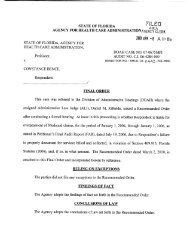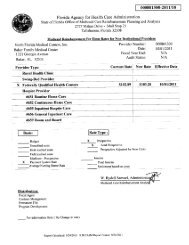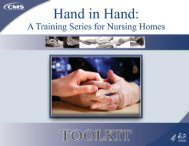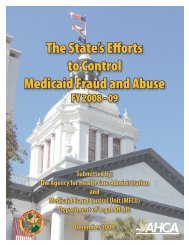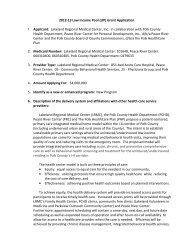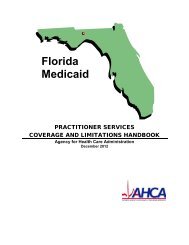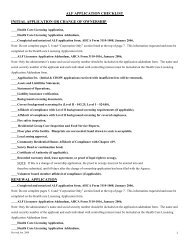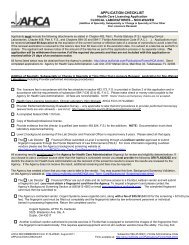DRAFT MEETING MINUTES - Agency for Health Care Administration
DRAFT MEETING MINUTES - Agency for Health Care Administration
DRAFT MEETING MINUTES - Agency for Health Care Administration
You also want an ePaper? Increase the reach of your titles
YUMPU automatically turns print PDFs into web optimized ePapers that Google loves.
- <strong>DRAFT</strong> <strong>MEETING</strong> <strong>MINUTES</strong>-<br />
Florida Commission on Review of Taxpayer Funded Hospital Districts<br />
Meeting Date: July 20, 2011<br />
Time: 10:00a.m. – 4:00 p.m.<br />
Location: <strong>Agency</strong> <strong>for</strong> <strong>Health</strong> <strong>Care</strong> <strong>Administration</strong>, Conference Room B<br />
Members Present: Dominic Calabro, Chair, Brad Dinkins, R. Paul Duncan, Jacob C. Jackson<br />
(via phone), Marshall Kelley, J. Scott McCleneghen (via phone), Randall McElheney,<br />
Representative Matt Hudson, and Jeff Gregg, Executive Director.<br />
AHCA Administrators and Staff Present: Kaylyn Boles, Beth Eastman, Marsha Webb, Rydell<br />
Samuel, Ester Kim, Bill McCort, and Cruz Conrad<br />
Interested Parties Present: Paul Belcher, Florida Hospital Association; Jennifer Hinson,<br />
Ausley & McMullen; Crystal Stickle, Safety Net Hospital Alliance of Florida; Sonya Sowards,<br />
Florida Tax Watch; Glenn Burhans, Greenberg Traurig; Blaine Cherry, Florida Tax Watch; John<br />
Benz, Memorial <strong>Health</strong>care System; Casey Perkins, Executive Office of the Governor; Eric<br />
Prutsman, Prutsman and Associates, PA; Jim Zingale, Safety Net Hospital Alliance of Florida;<br />
Tom Joos, Executive Office of the Governor; Christine Sexton, Florida Tribune; Bill Woeltjen,<br />
Sarasota Memorial Hospital; Warren Jones, Tallahassee Memorial Hospital; Dee Schaeffer,<br />
Halifax <strong>Health</strong>; Tony Carvalho, Safety Net Hospital Alliance of Florida; R.H. Hahn, Coventry<br />
<strong>Health</strong>care; Steve Purves, Munroe Regional Medical Center; Richard Mutarelli, Munroe<br />
Regional Medical Center; Melanie Pfister, Johnson & Blanton; Layne Smith, Mayo Clinic; Travis<br />
Blanton, Johnson & Blanton; James Call, Florida Public Radio; Amanda Prater, Florida House of<br />
Representatives; Eddie Metzger, Pittman Law Group; David Coburn, Capital Analytics; Lori<br />
Hundley, Parrish Medical and David Fifer, Akerman Senterfitt<br />
Welcome and Introductions: Dominic Calabro, Chair, called the meeting to order and<br />
welcomed the Florida Commissioner’s Review of Taxpayer Funded Hospital Districts<br />
(Commission members) and interested parties. The Chair requested the Commission members<br />
and interested parties to introduce themselves.<br />
Review and Approval of June 20 th Meeting Minutes: Chairman Calabro called <strong>for</strong> a review<br />
and approval of the minutes from the June 20 th Commission meeting. Representative Hudson<br />
made a motion to approve the minutes and it was seconded by Mr. McElheney. The motion<br />
passed.<br />
Impact of Medicaid Re<strong>for</strong>m: Representative Hudson provided an overview of House Bills 7107<br />
and 7109. As <strong>Health</strong>care Appropriations Chair of the House he realized that there was no way<br />
to do a budget, in the House, without addressing the Medicaid issue. Currently .28 cents of<br />
every tax dollar goes to one program and that is Medicaid. This impact on the State budget is<br />
tremendous as well as its impact on the healthcare delivery system in Florida is significant.<br />
Improving this is a challenge.<br />
Why did they do it is the big question. The .28 cents on the dollar is based on cost, utilization<br />
and enrollment trends, and this is expected to increase to .33 or .34 cents within the next<br />
1 | P a g e
several years. He noted that there was probably no one in the room on Medicaid, but that 1 in 6<br />
Floridians are, there<strong>for</strong>e this impact statewide is very significant. While most people aren’t on<br />
Medicaid, this increase has to come from somewhere; there<strong>for</strong>e, it will affect us all. There are a<br />
few problems with Medicaid. There is currently a pilot project, started by Governor Bush, going<br />
on in five different counties across the State (Baker, Clay, Nassau, Duval and Broward). There<br />
was a lot learned from this pilot project. The fee-<strong>for</strong>-service model is a very difficult model to<br />
manage. There are 80,000 providers with about 1.3 trillion lines of actual billables that were<br />
coming through and it is very difficult to weed out any fraud issues that may come along. There<br />
is also an issue with reaching the underserved communities. This was started 2 years ago. They<br />
looked at what was working and what wasn’t working. They looked at bits and pieces of<br />
programs all over to see what worked. In order to alleviate the problems they thought it was best<br />
to get out of the fee-<strong>for</strong>-service model and get into a managed care model. Representative<br />
Hudson noted that there are critics of both models. The State of Georgia played a big role as a<br />
model <strong>for</strong> how best to make the change.<br />
Overall, the new managed care model would help improve cost and utilization, provide better<br />
care in rural areas (access to specialty doctors/services), and the new system will be easier <strong>for</strong><br />
AHCA to manage and would ultimately help eliminate fraud. The new plan would also bring long<br />
term care into the scope. AHCA is required to submit the plan to the Federal government in<br />
August 2011 and they are unsure about how long this will take <strong>for</strong> approval. The anticipated<br />
timeline <strong>for</strong> implementation would begin in July 2012 with the procurement of long term care<br />
plans, then January 2013 with the procurement of managed medical assistance plan. In October<br />
2013 the enrollment in long term care plans would begin and October 2014 the enrollment in<br />
managed medical assistance plans would begin.<br />
Representative Hudson also noted that the new managed care model is not related to National<br />
<strong>Health</strong> <strong>Care</strong> Re<strong>for</strong>m, which could potentially add another 1.5 million participants to Medicaid<br />
increasing the amount to .40 cents on the dollar. This will be a huge problem <strong>for</strong> the state<br />
budget.<br />
Chairman Calabro asked what would happen if Florida does not get the Federal Medicaid<br />
waiver and when do we need to know that. Can we act presumptuous that we will get the<br />
waiver, etc? Representative Hudson stated that he would not presume anything that the Federal<br />
government would do. Historically there has been a strained relationship with them. There have<br />
been a lot of letters sent in from advocacy groups encouraging them to not approve it, so it will<br />
be interesting to see what happens. Chairman Calabro also asked have there been similar<br />
waivers in other states and what has been approved or denied. Representative Hudson stated<br />
that all parts of the plan have been approved in some shape or <strong>for</strong>mat in another state. Not<br />
collectively all together but in pieces.<br />
Mr. Kelly asked about discussing the provisions dealing with hospitals, specifically<br />
intergovernmental transfers, essential providers and the DRG study. He also noted that he<br />
agrees with this and has looked at a lot of states and many are all managed care.<br />
Representative Hudson directed the members to look at the handout of HB 7107, page four, <strong>for</strong><br />
in<strong>for</strong>mation on intergovernmental transfers (IGT). He noted that IGTs are a challenge and are<br />
very confusing. He explained that a local community, taxing district, or a county can effectively<br />
raise money to give to the state, which is then sent to the Feds and matched with Medicaid<br />
matching dollars. The money then comes back to the local community with part of the match of<br />
the additional dollars and gets spread out to hospitals around the state of Florida to handle<br />
some of the low income population that they may not be compensated <strong>for</strong>. He then explained<br />
that <strong>for</strong> the essential providers they tried to lump everybody and not leave anyone out.<br />
2 | P a g e
Representative Hudson noted that they tried to include everyone and not leave anyone out.<br />
They also included the medically needy in the managed care plan. There are approximately<br />
75,000 medically needy people at any given time in the state of Florida. This population is very<br />
unique as they aren’t typically Medicaid eligible, because of income status, or they are in a<br />
situation where they cannot get regular insurance or they are simply a medically complex<br />
individual. He noted that hospitals will be reimbursed <strong>for</strong> these cases and that even though it<br />
doesn’t seem like a lot of people, they are an expensive group of people.<br />
Mr. Jackson asked <strong>for</strong> elaboration on the two instances of where the low income pool (LIP) has<br />
been changed as it relates to managed care. Representative Hudson asked if he would email<br />
Director Gregg and he will provide a more detailed and accurate response.<br />
Chairman Calabro responded with another question about changes to the low income pool and<br />
do we look at what works and doesn’t work with the low income pool today. Representative<br />
Hudson responded that the low income pool has a lot of challenges. The council that looks at<br />
how the money is split up is a perpetual battle between the <strong>for</strong>-profit and not-<strong>for</strong>-profit industry to<br />
make sure that everyone is getting their slice of the pie. The council comes up with a<br />
recommendation and without any hesitation the Legislature passes it and does what they want<br />
to. He stated that systemically it is broken in terms of how it is divvied up.<br />
Dr. Duncan commented that the approval of the previous waiver created the low income pool<br />
with a short list of very specific objectives about where the money could come from, how it<br />
would be matched and how it had to be distributed. He mentioned that you couldn’t have a<br />
program that said here’s the money you put it on the table, you match it, you send it back,<br />
here’s the money, put it on the table, and so on. He stated this could not be done. The Federal<br />
government required that it be distributed more widely than that and had specific expectations<br />
about how that would happen. His research indicates that this has happened. He stated that no<br />
one knows how the modifications in the new language will impact this.<br />
Mr. Jackson commented that one of his questions about the low income pool is the issue about<br />
whether or not the money follows the patient. With the new changes to the low income pool and<br />
methodology, <strong>for</strong> example, if we have some private hospitals who are given low income pool<br />
money are we able to measure if that money matches the number of patients as well as with the<br />
public hospitals that need to be audited. What is the methodology of making sure the money is<br />
truly following the patient and to make sure they are being matched together? Chairman<br />
Calabro commented that it is a critical part and as we look at the hospital districts there is a<br />
growing concern that the money follows the patient. Representative Hudson commented that it<br />
is in part a philosophical question about whether or not various types of organizations are<br />
getting various types of money and then there is another question that is more data driven. On<br />
the philosophical question, assuming that they are receiving money, are they expending it in<br />
ways that align with the intentions of the Legislature. At the level of the first round was to follow<br />
the CMS terms/conditions. We should explore this question and how to follow that money. At<br />
the second level, <strong>for</strong> those that are receiving LIP money, are they delivering new care in<br />
exchange <strong>for</strong> that.<br />
Chairman Calabro then asked if there was a way that we can ask that the Legislature to adopt<br />
considerations to ensure, encourage or incentivize health outcomes in some consideration of<br />
feasible costs in allocating funds <strong>for</strong> LIP and other types of programs, so that we recognize<br />
those that do their job with tougher patient caseloads at a reasonable cost. Representative<br />
Hudson responded that recommendations to the Legislature can be made <strong>for</strong> anything;<br />
3 | P a g e
however, this is so demographically challenging to compare some of these patients. It would be<br />
hard to come up with a metric system to compare based on demographics and it would be a<br />
challenge to distribute LIP money based on outcomes. He noted that if there was a metric<br />
created to incentivize good outcomes, what would it be, based on a level playing field.<br />
Mr. Jackson stated that one of the basic questions that we want to look at whether or not<br />
entities are receiving LIP funding and the decreases that is happening on a continual basis. This<br />
may be of concern to the taxpayer regarding a pattern over time. There doesn’t seem to be an<br />
identifiable methodology about how money is being distributed. Is there a methodology to track<br />
this? Dr. Duncan replied that there is not a state of the art methodology <strong>for</strong> pursuing that kind of<br />
question. He then explained that part of it is contradictory, on one hand we are trying to achieve<br />
efficiency by aggregating 80,000 providers in the state to a smaller number or average. He went<br />
on to explain that patients want to see data based on the individual level, not an average of all<br />
patients. Representative Hudson commented that most of this is connected to the IGT.<br />
Mr. Kelly asked if there was a definition of what is meant by “money follows a person”. He noted<br />
that he had heard several meanings and would like clarification. He stated that we need this as<br />
it is part of the mission of the Commission. Dr. Duncan agreed and that it had not been clearly<br />
defined as it relates to the taxing districts. Representative Hudson stated that being able to track<br />
money by person will be very challenging. Mr. Jackson stated that it may be better to say<br />
“money following the population.” He gave the example of an increase in LIP funding; however,<br />
the funding <strong>for</strong> the population to be served by that has decreased within that system.<br />
Representative Hudson agrees and that a metric could probably be created in that regard to<br />
some degree; however, he is still unsure how this can be tied to the outcome data.<br />
Chairman Calabro asked if AHCA could determine where some of the Medicaid reductions are<br />
occurring.<br />
Review of Commission Survey Material Submitted by Hospital Districts: Director Gregg<br />
provided a summary of the responses received from the hospital districts in response to the<br />
letter sent in May. The letter contained nine questions. There were several districts that haven’t<br />
submitted responses yet, but they are expected soon. The summary sheet will be updated to<br />
reflect the new in<strong>for</strong>mation as it becomes available. Director Gregg also presented a matrix of<br />
hospitals, which includes hospital name, county, ownership (For Profit, Not <strong>for</strong> Profit or<br />
Government), number of acute care/specialty beds, and the hospital district it is part of (if any).<br />
This list is to assist the Commission in determining the publicly funded hospitals and provide a<br />
framework <strong>for</strong> the hospitals that need to be examined further. Director Gregg stated that staff<br />
will review the responses more thoroughly and contact facilities/districts to fill in the missing<br />
in<strong>for</strong>mation.<br />
Director Gregg noted that there has been a communication challenge with Tampa General<br />
Hospital. There have been three letters received from them and they don’t think this applies to<br />
them. He will continue to pursue obtaining more in<strong>for</strong>mation from them. He later noted that a<br />
response has not been received from Jackson Memorial; however, he has spoken with them<br />
and expects a response in August. This in<strong>for</strong>mation should be available by the next meeting.<br />
Director Gregg also noted that they are not a special taxing district; they are a unit of county<br />
government (Miami Dade County Public <strong>Health</strong> Trust). Representative Hudson stated that<br />
initially Jackson Memorial wasn’t on the list and he inquired about that, because although they<br />
are not technically a taxing district per se, they do spend a lot of taxpayer money and they have<br />
a unique role in Southwest Florida as it relates to access. He noted that it was important to put<br />
them on the radar screen.<br />
4 | P a g e
Dr. Duncan stated that the Commission, at some point, needs to come up with a more<br />
manageable list. He noted that there are facilities that may need to be included, that weren’t<br />
originally and some excluded that are currently on the list. He stated that coming up with the list<br />
will be hard to do, but it will make it easier to make recommendations. Chairman Calabro<br />
agreed. He noted that the Commission needs to figure out how to break down the tasks as<br />
outlined in the Executive Order into workable components. He went on to note that as part of<br />
this the Commission needs to know who is in and who is out. There was discussion about how<br />
to define tax dollars, whether by a taxing district or public trust. Mr. McElheney suggested that<br />
we look at the intent of the language. Mr. Kelly suggested that if you look at tax dollars, all<br />
hospitals receive tax dollars (Medicaid, Medicare, etc.). Mr. McElheney noted that it is not fee<strong>for</strong>-service,<br />
but appropriations. Mr. Kelly suggested that in order to avoid issues with defining tax<br />
dollars you can create multiple tables with and without the facilities in question (i.e., Jackson<br />
Memorial). This will also help alleviate issues with those larger facilities skewing the data.<br />
Chairman Calabro agreed and noted that the facilities may fall under taxpayer supported even<br />
though they aren’t in a taxing district. He stated that knowing this in advance will help as they<br />
move <strong>for</strong>ward.<br />
Public Comment: The Commission members received comment from Mr. Steve Purves,<br />
President and CEO, Munroe Regional Medical Center. Mr. Purves first thanked the Commission<br />
<strong>for</strong> the opportunity to speak. He then explained that he was at the meeting because his facility<br />
had been mentioned several times at Commission meetings and he would like to provide some<br />
detailed in<strong>for</strong>mation about Munroe Regional Medical Center. The hospital has been around <strong>for</strong><br />
about 113 years and was the fourth hospital established in the state. It was created as a mission<br />
to serve the needs of the community, which is still the mission today.<br />
They operate under the Marion County Hospital District, which was created in 1965 to help fund<br />
citizen care in the community. He noted that that was a long time ago and things have changed<br />
since that time. The District is governed by a seven member board of trustees. They have the<br />
fiduciary responsibility of the district and all aspects of the district are under the Munroe<br />
Regional <strong>Health</strong> System, Inc. (MRHS). They were created by the district to manage and operate<br />
cost cutting. This is because of law changes that allowed public hospitals to lease operations to<br />
private organizations. He then went on to explain that today the hospital is run under the MRHS<br />
board, which consists of the seven trustees and six non-trustee directors. The seven trustees<br />
are trustees of the district and the six non-trustee directors help round out the board of MRHS.<br />
They represent the community, bring expertise and broaden the capabilities of the board.<br />
He noted that MRHS is not a management company and that they were created to carry out the<br />
mission of the hospital. The District itself does not have tax levying authority, which lies with the<br />
County Commission. The trustees can only make recommendations. Mr. Purves then discussed<br />
the comparison of the percentages of those providing indigent care in the community between<br />
MRMC and Ocala Regional Medical Center. He noted that it was misleading to look at only the<br />
percentage of charges, because charges vary between hospitals. He then noted that another<br />
aspect that the Commission is interested in is the amount of tax support that is funded and<br />
where that money is going, how it is being used and is it efficient.<br />
He stated that between 2005 and 2009, ORMC has received $3 million dollars from the county<br />
<strong>for</strong> indigent care. He noted that MRMC or the hospital district has not requested or received any<br />
levy or tax support <strong>for</strong> 30 years. MRMC has conducted several cost efficiency analyses and it<br />
was concluded that their issue is a revenue issue – not a cost issue. He stated that in their<br />
strategic plan it was very clear that from the trustees that they needed to find supplemental<br />
5 | P a g e
sources of revenue. In conclusion he asked that when the Commission makes their<br />
recommendations that they won’t rush to conclusions about cost efficiency, transparency and<br />
the operation of a public institution.<br />
Chairman Calabro noted that Mr. Purves made a compelling argument about the difference<br />
between cost and charges and that costs are simply costs. He then asked why a <strong>for</strong>-profit<br />
hospital is receiving tax help when a not-<strong>for</strong>-profit hospital isn’t. Mr. Purves stated that you<br />
would have to go back a long time and look at the landscape at the time. He explained that in<br />
the early 1990s there was a concern about indigent care and in order to convince the HCA<br />
hospital to participate in the plan the county put aside about $2.4 million dollars to be distributed<br />
to a variety of sources. So, money was allocated to the hospital so that they would participate in<br />
the program. At that time, MRMC did not accept any money.<br />
Chairman Calabro asked if the hospital district had ever levied a tax and Mr. Purves responded<br />
that it had not in over 30 years. The money that is received from the County comes from their<br />
general appropriations. Mr. Kelly stated that the Commission has been given distinct tasks in<br />
the Executive Order and that any recommendations from MRMC or any other hospital would be<br />
helpful in addressing each task.<br />
Review of Issues Regarding Oversight of the Special Districts: Director Gregg stated that<br />
AHCA is not involved with the districts, only the hospitals. The Department of Community Affairs<br />
(DCA) oversees the Districts. Director Gregg spoke with lobbyist, Chris Lyon, who represents<br />
the Florida Association of Special Districts, who then referred him to Jack Gaskins at DCA.<br />
During his conversations with them he learned that the hospital districts make up a small portion<br />
of all special districts in Florida. Mr. Gaskins referred Director Gregg to a lot of in<strong>for</strong>mation on<br />
the special districts. He learned that the accountability of the special districts is the same as that<br />
of elected officials. Commission members would like to have Mr. Lyon or Mr. Gaskins come to a<br />
meeting to discuss special districts in more detail and to answer any questions.<br />
Meeting Summary and Adjourn:<br />
Director Gregg provided the Commission members with the next steps. They are as follows:<br />
1. Presentation by Phil Williams on Medicaid rate setting and related issues<br />
2. Presentation by Palm Beach County<br />
3. Presentation by Lee Memorial Hospital<br />
4. Presentation by Jack Gaskins – general in<strong>for</strong>mation about special districts<br />
5. Update of spreadsheet from first meeting by AHCA Financial Analysts<br />
6. Update of large matrix with new in<strong>for</strong>mation as it becomes available<br />
7. Continue to update/refine hospital list<br />
8. Provide additional in<strong>for</strong>mation on the single hospital license versus multiple hospital<br />
license (i.e. hospitals with premise hospitals all using same license number)<br />
9. Provide additional in<strong>for</strong>mation on the organizational structure of districts – trustees of the<br />
districts and those operating the hospitals<br />
10. Provide more detailed in<strong>for</strong>mation on the low income pool program – Representative<br />
Hudson and AHCA staff will provide more in<strong>for</strong>mation<br />
6 | P a g e
11. Provide additional in<strong>for</strong>mation on the compliance mechanism if a consumer has a<br />
complaint about a hospital district<br />
12. Provide additional in<strong>for</strong>mation on the type of tax funding each district receives – LIP<br />
funds, appropriations, etc.<br />
13. Provide additional in<strong>for</strong>mation on the trend of the districts; millage rate increases, etc.<br />
The meeting adjourned at 2:30 p.m. The next scheduled meeting is August 16, 2011.<br />
7 | P a g e



